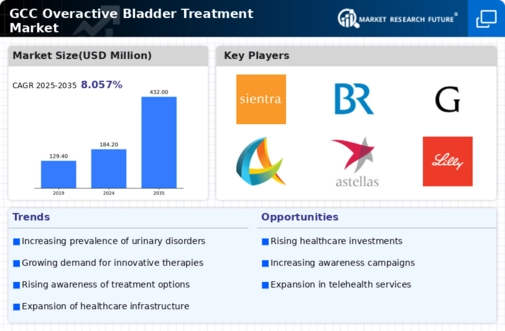The competitive insights of the GCC Overactive Bladder Treatment Market reveal a landscape characterized by a growing demand for innovative treatment options and advancements in pharmaceutical formulations. As the prevalence of overactive bladder increases in this region due to demographic changes and rising awareness about the condition, various players in the market are continuously enhancing their product portfolios through research and development. The market is marked by both established pharmaceutical companies and emerging startups, indicating a varied competitive environment that drives competition and innovation.
Companies are focusing on strategic partnerships, collaborations, and investments in new technologies to improve patient outcomes and expand their market reach.
Regulatory approvals and pricing strategies also play crucial roles in shaping the competitive dynamics as companies seek to navigate complex regulatory frameworks and provide affordable yet effective treatments to patients.H drug company possesses a robust market presence within the GCC Overactive Bladder Treatment Market, leveraging its extensive portfolio of pharmaceuticals aimed at this specific condition. The company benefits from well-established relationships with healthcare providers and pharmacies, ensuring that its products reach a broad audience.
Strengths of H drug company include its innovative research capabilities, which allow for the continuous development of new therapies that respond effectively to the needs of patients suffering from overactive bladder.
The company's commitment to quality and safety in its product offerings has positioned it as a trusted name among healthcare professionals and patients alike. Additionally, the company's strong marketing strategies and localized approaches have further cemented its foothold within the GCC market.Sientra has translated its offerings into a significant presence in the GCC Overactive Bladder Treatment Market, with a range of key products tailored specifically to address the challenges associated with overactive bladder. The company’s strengths lie in its ability to innovate and adapt, frequently updating its product line to meet the evolving needs of patients.
With a focus on building strategic partnerships, Sientra has engaged in various collaborations that augment its market presence and enhance its service delivery in the GCC region. The company's commitment to customer education and support empowers patients and healthcare providers by ensuring they have access to comprehensive information regarding their treatment options. Additionally, Sientra's strategic mergers and acquisitions have allowed it to expand its footprint in the GCC, thereby strengthening its operational capabilities while also diversifying its product range aimed at the overactive bladder segment.
Through these efforts, Sientra has effectively positioned itself as a competitive player in the market, dedicated to addressing the needs of patients in this arena.























Leave a Comment